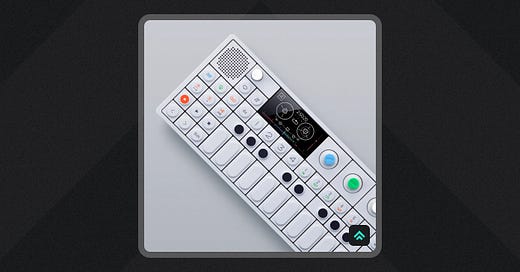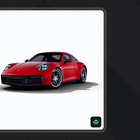Teenage Engineering OP-1: The micro synth with massive impact
The unexpected journey of a portable synthesizer that captured the public imagination and launched a powerhouse design studio
Hello! I’m Pat and Better by Design is my newsletter where I deconstruct the art and science of hit designs and share the lessons. Each week I put my multidisciplinary skill set to the test to show great design in action so that you can replicate the success in your own creations!
Intro
How does a toy-like instrument shake up the music industry and land in the permanent collection at the SF MoMa?
Today we’ll dig into the unexpected journey of the OP-1 portable synthesizer, a product that challenged what we thought we knew about music technology, and launched Teenage Engineering, one of the world’s most significant, modern, design studios.

Background
What do you think of when you picture a synthesizer?
For me, it’s: Bulky and heavy, with a million cables, switches, knobs, and dials.
It’s like you took the complexity of learning to be a good musician, layered on a bunch of technical concepts, and then topped it off with a mind-boggling array of ever-changing software and hardware.
It’s an intimidating learning curve.
But in 2005, Jesper Kouthoofd, Jens Rudberg, and David Eriksson founded Teenage Engineering (TE) to create a new path forward for this technical instrument.
Their goal wasn’t merely to add another entry to the saturated market but to reshape the landscape entirely. Could they merge their design, technology, and music expertise to make synths more approachable for non-engineers?
After an initial period of discovery, the team homed in on an idea: the OP-1 Portable Synthesizer. They introduced OP-1 in 2011, and from the start, it was clear that it was no ordinary synth. It challenged the status quo by merging a synthesizer, sampler, and sequencer into a compact, portable device that broke through the intimidating facade of the synth market.
What set OP-1 apart wasn't just its portability or multi-functionality, but its playful minimalism. In an industry that equated professionalism with complexity, OP-1 was refreshingly simple, yet stunningly powerful. Its almost toy-like design disguised a serious set of capabilities, a magic trick that won the hearts of both the music and design communities. It went on to win awards like the Georgia Tech Margaret Guthman award for being one of the “newest and greatest ideas in music” and can now be found in the permanent collection of the San Francisco MoMa, a testament to its innovative design.
The success of OP-1 wasn't only a victory for Teenage Engineering. It was a victory for the idea that audio tech can be accessible, inviting, and beautifully designed without compromising on power and versatility. OP-1 laid the foundation for a new vision of what music technology could be, opening the door for more innovative products to pick up where it left off and carry Teenage Engineering’s design-forward ethos to new corners of the market.
The success of OP-1 is a great reminder that often, to make big noise in an industry, you have to be willing to play a different tune.

Product context
Cultural fuel
OP-1 didn’t brute force its way into the market but rather it rode a few cultural waves to land the right idea with the right people at the right time.
Macro trends
Democratization of music production via “in-the-box” techniques
By the early 2010s, fully “in-the-box” (100% on a computer) music production had taken over. While making music on the computer wasn’t a new phenomenon, the power available on personal machines had made it possible for anyone to make professional-grade music on a laptop.
However, a downside of making music exclusively “in-the-box” is that it’s effectively infinite, with much of what’s available only distracting from making music. You can browse sample libraries forever, you can tweak every possible setting of every plugin, you can fall down yet another YouTube rabbit hole, and so on. It’s easy to get lost in the endlessness and end up making nothing at all.
Mainstreaming electronic music
The early 2010s saw the mainstreaming of artists like Skrillex, Deadmau5, Avicii, and many more. Dance music took over the radio. DJs headlined festivals. Genres merged and split as production techniques from electronic music spilled over into basically every other type of music.
Micro trends
Needing to “be an engineer” to get the most out of synths
As electronic music was reshaping the popular idea of what it meant to be a musician, there was still a lingering mental model that synths were just for engineers. The market hadn’t yet adjusted to produce something that delivered on the newfound public openness to consuming and making electronic music.
Either big, heavy, quality gear or small, light, cheap gear
No matter how you sliced it, the synths available at the time were either:
Big, heavy, and quality
Small, light, and cheap
This meant there was a unique opportunity for a product that could innovate and provide high quality in a small form factor. After all, music production had shifted from the studio to the bedroom where space was at a premium.
Competition
The professional audio equipment and synth markets are crowded and competitive with a number of established players.
Stalwarts like Moog, Roland, and Korg have longstanding reputations for making quality synthesizers. Meanwhile, companies like Novation, Arturia, and Akai have also built strong followings, particularly around MIDI controllers.
By combining features from across synths, samplers, and sequencers, Teenage Engineering created a unique niche for OP-1 where it has no true, direct competitors. Instead, it faces indirect pressure from several independent vectors. Basically, if you want OP-1, there’s only one way to get it. But if you’re looking for a standalone synth, sampler, keyboard controller, etc… the market is full of reasonable alternatives.
Audience
OP-1 is targeted at music professionals.
However, this has bled over into high-end electronic music hobbyists as the concept of “music professional” has continued to expand over the course of the last decade.
Pricing
The premium nature of OP-1 was reinforced by its price at launch: $849.
Over the last decade, OP-1 has only gone up in price and is currently listed on the company’s website for $1399. Its successor, OP-1 Field costs $1999 😅.
For comparison:
On the lower end, Arturia’s Microfreak synth retails for $405.
On the higher end, offerings from Moog tend to land in the $1,000-$2,000 price range (Grandmother synth at ~$1000, Matriarch at ~$1900)
Again, these aren’t one-to-one comparisons, but they give a sense of the wide range of prices OP-1 might go up against when determining a sale.
In any case, it’s obvious Teenage Engineering prices OP-1 as a premium product.
Levers of design impact
Innovation
Portability
OP-1 was significantly smaller and more portable than most synthesizers available at the time. It had a slim and compact form factor, allowing it to be used almost anywhere. This was particularly useful for touring musicians as well as bedroom producers where space is limited.
Multifunctionality
OP-1 wasn't just a synthesizer but also a sampler, sequencer, and four-track recorder. This all-in-one design was unique at the time and added to its appeal. Having this combination onboard OP-1 made it a perfect choice for sketching out new ideas in a space that offered more creative flexibility than a single-function device, yet clearer constraints than the infinite options of a full digital audio workstation on a laptop.
Functionality
Utility
Instruments are meant to be played, not sit on the shelf collecting dust.
The design of OP-1 leaned into being an instrument, not a piece of consumer tech, and encouraged routine use by making it fully playable as a standalone device.
Understandability
OP-1 focused heavily on making its physical and digital interfaces intuitive.
A prominent way this manifested was through color coding. TE aligned the physical and digital interfaces of OP-1 with color, making them more visually appealing as well as making them easier to understand and use compared to other synths.
Build quality
OP-1’s build quality lived up to its premium price tag. It had a high-end feel with its aluminum chassis and quality components, differentiating it from many synths and keyboard controllers which were often made from plastic.
Aesthetics
The clean, minimalist, and retro-futuristic design of OP-1 set it apart from other synthesizers on the market, which often had a more traditional retro aesthetic.
Sustainability
Focus on the essential details
The size constraint of OP-1 forced the design to nail the essential details.
There simply wasn’t room for fluff.
Removing non-essentials made the included features more thorough and robust, giving them a long-lasting shelf-life.
Longevity
OP-1 sells for 65% more now than it did upon its release 12 years ago.
This is fascinating to me as it shows that OP-1 is both designed and valued more like a high-end instrument rather than a piece of consumer technology.
It’s designed to last.
For comparison, the iPhone 4s also came out in 2011 and is now mostly obsolete as a daily-use device. Meanwhile, OP-1 is as relevant as ever and continues to power Teenage Engineering’s business.

How to replicate OP-1’s success
“The styling, sound, and interface of the OP-1 were all an effort to do something completely opposite to the prevailing trend in synths at the time” - The Verge
1. “Hate something. Change something.”
With OP-1, Teenage Engineering had a clear point of view.
They may not have known exactly what they wanted to make, but they did know what they didn’t want to make.
In particular, they were against infinite choice, formality, and inaccessibility. This gave them clear anchors from which to drive action.
Infinite choice → Reduce the options of “in-the-box” production to something playable
Formality → Challenge the notion that serious tools can’t be fun and inviting
Inaccessibility → Make the device easy to pick up and play
When you’re making something new, it’s hard to find the words to describe it.
So instead, focus on articulating what you’re against.
State what you hate and pick your enemies.
These are your problems and your purpose is to solve them.
Go forth and conquer.
“Usually you have an idea and then you go and manufacture it, but we buy the machine first and then explore the machine itself – a router or a laser cutter or a 3-D printer,” says Kouthoofd. “Then you start to experiment and think ‘What can I do with this machine?’ We love machines and we want to see what happens when you put a creative person next to the machine as opposed to a classical engineer. Buying a machine before you know what to do with it is a big part of the whole Teenage Engineering approach.” - Fast Company
2. Materials first, then shape with design
Teenage Engineering does the opposite of what most design advisors would tell you to do: they start with the materials (the technology), not the people.
They understand that innovative design moves in tandem with technology.
By starting with the material, they’re able to design intentionally toward its strengths and avoid its weaknesses, leading to more robust and long-lasting solutions.
Then they’re able to prototype extensively to test ideas in the real world with real people, gathering feedback and iterating on concepts before putting them into production.
You always have to eventually match the product to a person, but starting with the materials rather than the use case is an often overlooked path for designing innovative and resilient products.
“To have a portable machine which is dedicated to making music is a big difference compared to a computer, on which you can do a lot of other stuff,” he explains. “We hope that you get a little bit more focused and perhaps a little bit more creative as well. One of the most inspiring things about the OP-1 is that it can’t do everything that a computer can do. Those limits boost the creativity. Limitations are OP-1’s biggest feature.” - Fast Company
3. Leverage constraints as benefits
OP-1 is multi-functional, but single purpose: it exists to make music.
It provides a suite of powerful tools, sets constraints for the musician, and then gets out of the way to let the user tap their creativity to get the most out of the device.
Many product teams fall into the trap of trying to solve every customer problem for every customer with a new feature, but that’s a surefire way to end up with a brittle and overly complex tool.
Instead, leverage constraints as a benefit.
Provide flexible, powerful tools, and then get out of the way.
Humans are more creative than companies give them credit for.
Let them use it!
“You can design to remove expectations and change the behaviour of the people who use your products” - Jesper Kouthoofd
4. Use aesthetics to drive specific outcomes. Don’t chase it for its own sake.
Many product teams fall into one of two traps:
They assume aesthetics don’t matter because they’re hard to quantify
They chase aesthetics for their own sake, leading to rabbit holes that return little value
Don’t drive yourself into this avoidable ditch.
Instead, follow TE’s approach by leveraging aesthetics strategically to drive specific outcomes.
For example:
While OP-1 is still a very complex product, TE used its visual design language to make it feel less complex.
OP-1’s toy-like, retro-futuristic style intentionally put it in stark contrast to the rest of the market, helping it gain significantly more mindshare than it might have otherwise.
OP-1’s minimalist white and metal frame avoids drawing attention to non-essentials when the focus should be on playing.
OP-1’s limited and intentional use of color lessens the formality of the device while serving the practical purpose of aligning hardware and software interfaces.

Next week
Next week on Better by Design we’ll look at how a single text box changed the way we interact with the internet.
That’s right. We’re looking at Google search.
With the recent surge in AI interfaces as a kind of evolutionary search experience, I think it’s worth revisiting one of the biggest breakthroughs of the last generation to see what we might learn to apply to the next-gen.
Don’t miss it!
If you got a little value from this post, consider subscribing, sharing, or following me on Twitter. If you got a lot of value, consider pledging to support my work with a paid subscription in the future.








Another product that made an impact in the market and created a whole category by/ti itself and in a totally different market: Flaneurz. Check-it out. They get little by little more and more recognition.
First principles thinking can sometime innovate and rethink solutions with the current technology that legacy systems might just not consider. Inspiration and problem solving skills are key and this is a great story of how human needs drive innovation.